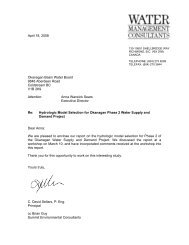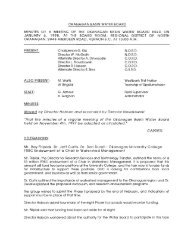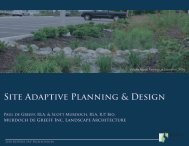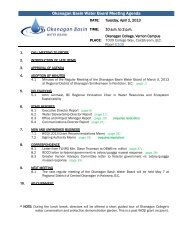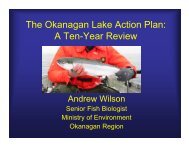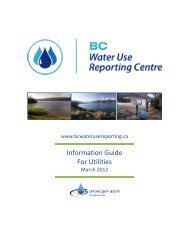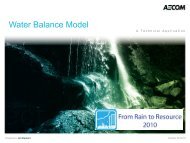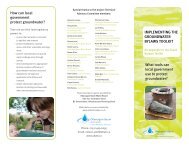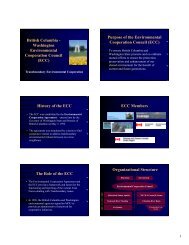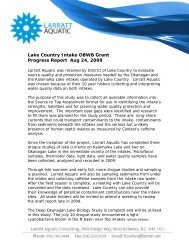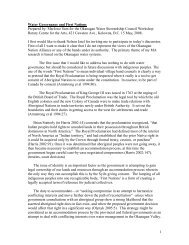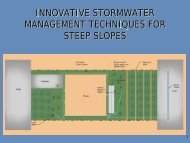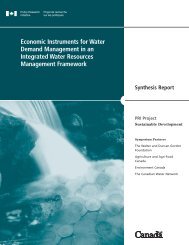Instream Flow Needs Analysis - Okanagan Basin Water Board
Instream Flow Needs Analysis - Okanagan Basin Water Board
Instream Flow Needs Analysis - Okanagan Basin Water Board
- No tags were found...
Create successful ePaper yourself
Turn your PDF publications into a flip-book with our unique Google optimized e-Paper software.
FINAL<strong>Okanagan</strong> <strong>Basin</strong> <strong>Instream</strong> <strong>Flow</strong> <strong>Needs</strong>1 Introduction1.1 BackgroundThe <strong>Okanagan</strong> <strong>Basin</strong> consists of headwater lakes, tributary streams that flow to lakes and the river at thevalley bottom, six large main valley lakes and <strong>Okanagan</strong> River. The basin crosses the international borderwith the United States and ultimately drains into the Columbia River. Many of the headwater lakes havebeen dammed at their outlets and are regulated for domestic and irrigation water supplies. Most tributarystreams flow into <strong>Okanagan</strong> Lake, but a few enter other lakes and the <strong>Okanagan</strong> River. The streams aredriven by snow melt so that their peak flows occur over a two-month period in spring, which is followedby low water flow in summer, autumn, and winter. This pattern of annual flow is out of synchrony withhuman water uses, especially irrigation, which peaks in summer and early autumn. <strong>Water</strong> withdrawalsfrom streams are a significant issue, affecting the quality and quantity of fish habitat available. The<strong>Okanagan</strong> River and tributary streams provide critical habitat for numerous fish species, includingspawning habitat for kokanee and sockeye salmon, and rearing/spawning habitat for Chinook, rainbowand steelhead trout and other resident species. As a result of water withdrawals, dams for flood controland continuing land development fish habitat has been severely impacted (or eliminated) throughout the<strong>Okanagan</strong> <strong>Basin</strong> (COBTWG 2005).The Province of B.C. initiated a <strong>Water</strong> Supply and Demand Project in 2004 in response to increasingconcern over impacts to fish habitat and the sustainability of water use in the <strong>Okanagan</strong> <strong>Basin</strong>, to evaluatedeveloping water issues in the <strong>Okanagan</strong> <strong>Basin</strong>. Phase 1 of this work (Summit Environmental ConsultantsLtd. 2005) identified and catalogued relevant data sources, identified data gaps, and developed a strategyfor completing Phase 2. The <strong>Okanagan</strong> <strong>Basin</strong> <strong>Water</strong> <strong>Board</strong> (OBWB), along with provincial and federalagencies and First Nations, then initiated Phase 2 of the project. Two primary tasks for Phase 2 weredeveloped in parallel. These first of these was a surface water hydrology and hydrologic modeling studywhich has now been completed (Summit 2009). The second task was to use information on “naturalized’flows for 1996–2006 (provided by the surface water hydrology and hydrologic modeling study) todetermine instream flow needs (IFN) for specific areas (“nodes”) that have been defined within the<strong>Okanagan</strong> <strong>Basin</strong>. These nodes consist of key tributary mouths, mainstem lakes, and key locations on the<strong>Okanagan</strong> River. The instream flow requirements study is the focus of this report, framing an IFNanalysis on information provided by the surface water hydrology study (Summit 2009) as well as pastwork completed for the <strong>Okanagan</strong> Fish-<strong>Water</strong> Management Tools project (Alexander et al. 2008).1.1.1 Methods consideredThe influence of water flows on aquatic species, particularly salmonids, is well established in thescientific literature (e.g., McCullough 1999; Oliver and Fidler 2001; and Richter and Kolmes 2005).Specific flow assessment methods are also well documented (e.g., EA Engineering Science andTechnology 1986, Jowett 1997, <strong>Instream</strong> <strong>Flow</strong> Council 2002). A great deal of work has been completedrecently in B.C. to review this literature and bring forward recommended instream flow standards foraquatic biota, with considerable amounts of consultation amongst provincial and federal agencies(Hatfield et al. 2002; Hatfield et al. 2003). More than 50 approaches are available for assessing minimumor optimum instream flow needs for fish (e.g., EA Engineering Science and Technology 1986; Jowett1997). Available instream flow assessment techniques can be categorized in different ways (e.g., Jowett1997, Summit Environmental Consultants 1998, Sawada et al. 2002), but a useful distinction is between1 ESSA Technologies Ltd. &Solander Ecological Research



